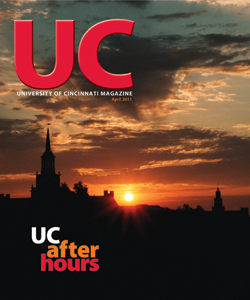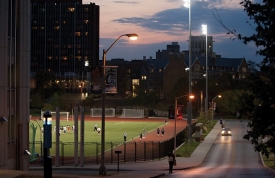Creating a safer UC
The father on the phone was upset. His son was now a student at the University of Cincinnati, which he had heard was a “dangerous” place. It’s the type of call with which UC police chief Gene Ferrara, Ed ’74, is all too familiar.
Despite a steady decade-long downward trend in the number of crimes that occur on campus, news of one robbery can skew public perception of UC as a “safe” place for students.
“I can’t tell you we don’t have crime, because we do,” Ferrara says. “But people need to understand that there is nowhere without crime and compared to our peer institutions, UC is a pretty safe place.”
In this case, Ferrara asked the father where his family lived. He then pointed out that FBI statistics reported seven robberies in the man’s small Ohio town during the last year. The parent was surprised. “They didn’t send an email every time something happened, so you didn’t know about it,” Ferrara responded. “That doesn’t mean it didn’t happen.”
The difference is UC does send an email alert for every crime reported on campus and within a half mile of campus. Not all schools take such steps. “Some of our students live off campus and faculty, staff and students might shop or eat there,” he says. “So we send emails because we think people ought to know about it. But that makes people think we have crime, and no one else does.”
In reality, when compared to other urban research institutions, including Ohio State University and Rutgers, with student populations of about 25,000 or more, UC’s rate of 1.73 crimes per 1,000 students is lower than the average of 2.87 for these schools. In other words, an individual’s risk of becoming a victim of any crime on UC’s campus is lower than the risk at many peer institutions. When comparing property crimes, which include auto-theft, burglary and arson, the average among peer institutions is 2.19 per 1,000 students, while UC’s rate is 1.03 — less than half.
Numbers are also important for the Uptown neighborhoods immediately surrounding the university, including Avondale, Mount Auburn, Corryville, Clifton, University Heights and Fairview, because 6,000 students live there, compared to the 4,000 living on campus. And those numbers are good. Through October 2010, violent crime — murder, rape, robbery and aggravated assault — was down in the Uptown area by 13.21 percent compared to the previous year.
The improved safety around campus did not happen by accident, and technology played a key role. A computerized access-control system allows security to lock and unlock doors on university buildings from one central location, and about 20 cameras help officers monitor suspicious activity throughout campus and solve crimes after they happen.
Even more prevalent than the cameras are the 200 help phones installed across all the UC campuses, with all of them quickly identified by blue lights. At any location on campus, an individual is within 200 feet of a phone, which rings directly to the UC Police dispatcher.
The Bearcat Transportation System, initiated by student government a few years ago, provides buses running from campus through the Uptown neighborhoods and downtown entertainment districts. Their popularity has grown so much that larger buses were needed last year.
And in area neighborhoods, UC Police have developed a model partnership with Cincinnati Police to ensure more cops on duty, with two “partner cars” patrolling up to half a mile off campus each night during the peak times that street robberies occur. The two departments also share radio communication systems.
While all these factors have contributed to making the university safer, Ferrara notes that education of the campus population is also key. Almost 90 percent of on-campus crime is theft, some of which could be easily avoided.
“If we could just get people to change their behaviors, we could drop crime even more,” he says, adding that removing valuables, like laptops, cell phones and iPods, from view in residence halls, cars or other public places would eliminate the temptation for most thieves.
Of course, no place is completely devoid of crime, stresses Ferrara. Sometimes introduced as the “police chief of the city within the city,” he says that UC operates with approximately 50,000 people on campus daily, plus university guests.
“The difficulty is that there’s an intrinsic belief that crime shouldn’t happen on a college campus. That only happens if you put a moat around our campus with a drawbridge, and you fill the moat with crocodiles and check every person coming on to campus,” Ferrara says. “But an educational institution is an open community.
“People can’t focus on learning if they are worried about someone jumping out from behind every bush. Our job is to make it as safe as we can so that the educational process can occur.”

 Past Issues
Past Issues